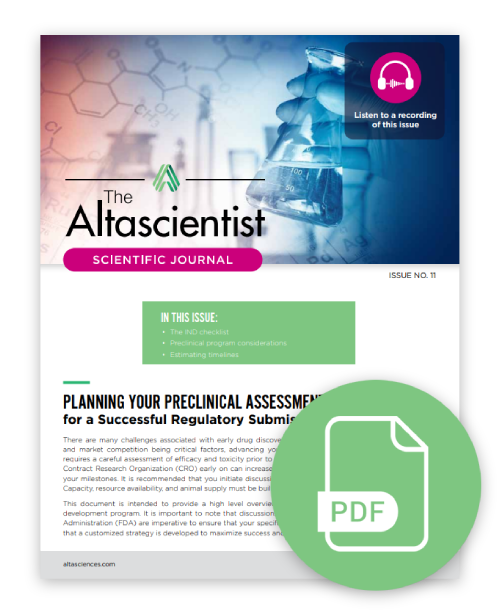ISSUE NO. 11 — Navigating the IND Submission Process
There are many challenges associated with early drug discovery and development. With timelines, budget, and market competition being critical factors, advancing your best candidate for regulatory submissions requires a careful assessment of efficacy and toxicity prior to entering human trials. Partnering with the right CRO early on can increase your chances of success and ensure you meet your milestones. In fact, we recommend initiating discussions with a CRO at least six months in advance to ensure that capacity, resource availability, and animal supply are built into your timelines.
timelines, budget, and market competition being critical factors, advancing your best candidate for regulatory submissions requires a careful assessment of efficacy and toxicity prior to entering human trials. Partnering with the right CRO early on can increase your chances of success and ensure you meet your milestones. In fact, we recommend initiating discussions with a CRO at least six months in advance to ensure that capacity, resource availability, and animal supply are built into your timelines.
In Issue 11 of The Altascientist, we provide a high-level overview of the preclinical component of your drug development program in preparation for regulatory submission, including:
- A submission checklist
- Pivotal toxicology studies
- Small molecules vs. biologics
- Considerations for before you begin (species selection, formulation, test article, bioanalysis, etc.)
- Small and large molecule timelines
- SEND data
- Selecting the right CRO for you
Preparing For Your IND Submission
Your IND application must contain information in the three following areas, as outlined by the U.S. FDA:
- Animal pharmacology and toxicology studies
- Manufacturing information
- Clinical protocols and investigator information
Moving a drug from preclinical testing into the clinic requires that all conditions outlined by the FDA be met. Therefore, it is important that you and your CRO have a thorough understanding of the requirements. Involving regulatory agencies from the start can help lead you in the right direction and ensure a successful IND submission.
It is essential to communicate with the FDA as early as possible to make certain that the test plan is acceptable. The pre-IND meeting is the first crucial interaction with the FDA. This meeting provides an excellent opportunity for you to enlist the FDA's support as well as validate and optimize a strategy.
Planning Your Pivotal Toxicology Studies
Being proactive in your approach and having a clinical strategy before engaging a CRO will ensure that the data provided by the program of work is sufficient to support your IND, and will reduce the risk of study start-up delays.
Considerations for planning your program include safe starting doses for clinical trials and multiple-dose levels (multiples of expected clinical dose), species selection and justification, routes of administration to mimic clinical use, identification of potential target organs for toxicity, planning for assessing reversibility of toxicities, endpoints, and analytical and bioanalytical methods.
Test Article Considerations
Proper formulation of drugs and vehicles helps ensure appropriate exposure to the test article. Vehicle/solubility, consistency, characterization, storage conditions and material safety data sheets must all be taken into consideration.
As such, solubility, stability, dose volume, and tolerability of the vehicle in the preclinical species should be considered. For GLP studies, concentration verification of the test article in the vehicle is required. It is also important that the route of administration for the IND portion of preclinical studies -mimic the route you intend to use in the clinic.
A well-characterized test article must be in accordance with GLP and accompanied by a Certificate of Analysis, and test materials should be stored according to the Certificate of Analysis and within the same conditions under which stability has been established.
Additionally, to ensure safe and proper handling of the material, the safety data sheet should be provided to your CRO study team and laboratory personnel before the test article is shipped.
Explore all issues of The Altascientist in our Resource Center. And don’t forget to subscribe to “The Altascientist: Audiobooks” on Spotify, Apple Podcasts, or wherever you get your audio content.